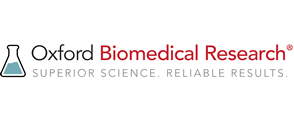Pricing and Availability:
Please contact us for prices and availability on any of the Oxford Biomedical Research range of products.
Eicosanoid Metabolism, Oxidative Stress, Signal Transduction, Vascular Biology and Xenobiotic Metabolism
Oxford Biomedical Research (OBR) produces an extensive range of assays, antibodies, proteins and reagents for researchers interested in Eicosanoid Metabolism, Oxidative Stress, Signal Transduction, Vascular Biology and Xenobiotic Metabolism.
Oxidative Stress
Isoprostanes are excellent molecular biomarkers for oxidant stress. Indeed, 15-F2t-Isoprostane (previously called 8-epi-PGF2α) is already widely recognized as the ‘gold standard’ of oxidant status. Oxford Biomedical Research introduced the first immunoassay for isoprostane over a decade ago and have been extensively validated using GC/MS. OBR’s newest Urinary Isoprostane Assay (EA85) contains specially formulated buffers that eliminate the need for costly and time consuming solid phase extraction.
Free radicals are so reactive and short-lived that direct measurement is usually not possible. However, hundreds of biomolecules are known to be derived from the interaction of free radicals with biomolecules. Assays for some of these oxidative stress biomarkers, as well as assays for several of the body’s antioxidant defense mechanisms, have been widely used. Although there are numerous tools on the market, a small number of oxidized lipids, as well as byproducts of DNA and protein oxidation, have withstood the test of time. OBR’s major goal is to provide you with straightforward, reliable assays for oxidative stress biomarkers and for antioxidant capacity of biological fluids.
Drug Metabolism
Xenobiotics are molecules that are not produced in vivo, but rather, are introduced into the body from the environment and subsequently metabolised by the body. Routes of introduction to the body include inhalation (e.g. aromatic hydrocarbons in cigarette smoke), intravenous (e.g. various anesthetics), transdermal and, for most pharmaceutical agents, ingestion. The metabolism of xenobiotics in our environment is an important field of investigation. However, to minimize risk and optimize therapeutic benefits, it is critical that the metabolism of candidate pharmaceutical agents be elucidated, including identification and properties of key metabolites.
Vascular Biology
Cardiovascular diseases (CVD) cause more deaths per year than the next six leading causes of death combined. There is also strong evidence for a role of oxidative stress, a key focus at OBR, in the development of CVD. Emerging risk factors for CVD include isoprostanes, C-reactive proteins, fibrinogen and plasminogen activator inhibitor 1 (PAI-1). Fibrinogen and PAI-1 are key components of the highly regulated coagulation process. Elevated PAI-1 transcription has been reported to be caused by oxidative stress activation of the AP-1 response element. Vascular endothelial cells also play a key role in cancer by limiting the access of circulating cells to sub-endothelial space and thereby reducing tumor metastasis.
OBR offer a wide range of antibodies, purified and recombinant proteins, and immunoassay kits for studies of proteins involved in cardiovascular biology – including those that play key roles in coagulation and its regulation, as well as other proteins that have been recognised as important in cardiovascular pathobiology.
Eicosanoid Metabolism
Two excellent biomarkers for inflammation are Histamine (EA31 Histamine EIA kit) and 15-Keto-13,14-Dihydro-PGF2α. Histamine serves as a mediator of inflammation and hypersensitivity responses and is involved in a cascade physiological effects that are influenced by typical immune response and environmental factors. 15-Keto-13,14-Dihydro-PGF2α is the major metabolite of PGFα and can be used as an unique biomarker of acute and chronic inflammation.

